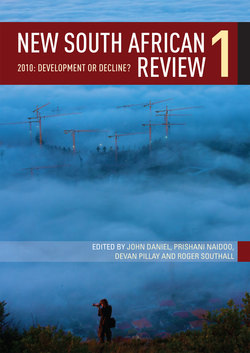Читать книгу New South African Review 1 - Anthony Butler - Страница 9
Reinforcing the minerals-energy complex
ОглавлениеSouth Africa’s economic trajectory from the late nineteenth century saw a shift away from an agrarian to a minerals-exporting country. Even though the expansion of mining stimulated wider industrialisation from the beginning of this transformation; even though from the 1920s onwards, nationalist governments implemented protective strategies which encouraged manufacturing; and even though by the 1960s the major mining houses had moved beyond their base in gold, diamonds, coal or whatever to become huge conglomerates spanning finance and industry as well as minerals, the economy remained dominated by what Fine and Rustomjee (1996) have identified as the minerals-energy complex (MEC). To be sure, the direct contribution of mining to GDP declined from 12.1 per cent in 1951 to 9.5 per cent in 2008. In contrast, that of manufacturing remained static (18.1 per cent in 1951 to 18.8 per cent in 2008), whilst that of finance grew from 9.3 per cent to 21.7 per cent (SAIRR 2008–09: 139). Nonetheless, although South African industry has achieved considerable capacity and success, the economy continues to bear the heavy imprint of the MEC. Most importantly, broad sectors of manufacturing, energy supply, construction and transport remain intimately connected with, if not dependent upon, mining and servicing its needs: ‘technical linkages between the two broad sectors have been significant and account for a substantial proportion of non-MEC manufacturing’ (Fine and Rustomjee 1996: 245). Further, as Nattrass (1981: 269) remarked nearly three decades ago, ‘South Africa remains heavily dependent upon the successful export of relatively few items and the composition of her exports largely reflects her natural resource endowment’. By 1990, manufacturing accounted for 80.2 per cent of exports and 96.7 per cent of imports, while mining accounted for 15.3 per cent of exports and just 1.64 per cent of imports. However, by 2008, manufacturing accounted for only 58.3 per cent of exports and 78.2 per cent of imports, while mining accounted for 37.9 per cent of exports and 20.3 per cent of imports (the latter figure obviously including oil) (SAIRR 2008/09: 139). Suffice it to say here that globalisation would seem to have enhanced South Africa’s dependence upon the MEC rather than encouraged a wider diversification of the economy. This might not matter so much except that the long-term trend is for the MEC to become increasingly capital intensive and to provide declining opportunities for employment.
Meanwhile, the liberalisation of the economy may well have intensified dependence upon foreign knowledge production rather than advancing it domestically, for the internationalisation of South African industry has probably rendered it more feasible for firms to draw on knowledge and research from global supply chains (which may themselves often be embedded in multinational company structures) (Lorentzon 2006: 195). While there is nothing wrong with exploiting foreign sources of knowledge, there is plenty wrong if this is not built upon by a concerted national system for industrial innovation. Such a system in South Africa remains in its infancy, due in considerable part, according to some authors, to the country’s lack of an integrated industrial policy (Morris et al 2006).
